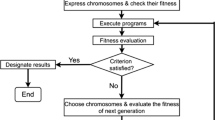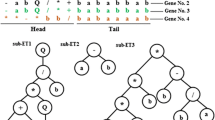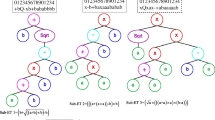Abstract
Numerous methods have been proposed to assess the axial capacity of pile foundations. Most of the methods have limitations and therefore cannot provide consistent and accurate evaluation of pile capacity. However, in many situations, the methods that correlate cone penetration test (CPT) data and pile capacity have shown to provide better results, because the CPT results provide more reliable soil properties. In an attempt to obtain more accurate correlation of CPT data with axial pile capacity, gene expression programming (GEP) technique is used in this study. The GEP is a relatively new artificial intelligent computational technique that has been recently used with success in the field of engineering. Three GEP models have been developed, one for bored piles and two other models for driven piles (a model for each of concrete and steel piles). The data used for developing the GEP models are collected from the literature and comprise a total of 50 bored pile load tests and 58 driven pile load tests (28 concrete pile load tests and 30 steel pile load tests) as well as CPT data. For each GEP model, the data are divided into a training set for model calibration and an independent validation set for model verification. The performances of the GEP models are evaluated by comparing their results with experimental data and the robustness of each model is investigated via sensitivity analyses. The performances of the GEP models are evaluated further by comparing their results with the results of number of currently used CPT-based methods. Statistical analyses are used for the comparison. The results indicate that the GEP models are robust and perform well.



















Similar content being viewed by others
References
Abu-Farsakh M, Titi H (2004) Assesment of direct cone penetration test methods for predicting the ultimate capacity of friction driven piles. J Geotech Environ Eng ASCE 130(9):935–944
Abu-Kiefa M (1998) General regression neural networks for driven piles in cohesionless soils. J Geotech Geoenviron Eng 124(12):1177–1185
Alsamman O (1995) The use of the CPT for calculating axial capacity of drilled shafts. PhD Thesis, University of Illinois, Urbana
Ardalan H, Eslami A, Nariman-Zadeh N (2009) Piles shaft capacity from CPT and CPTu data by polynomial neural networks and genetic algorithms. Comput Geotech 36:616–625
Briaud J (1988) Evaluation of cone penetration test methods using 98 Ple load tests. In: Proceedings of the first international symposium on penetration testing, ISOPT-1, Orlando, vol 2, pp 687–697
Briaud J, Miran J (1992) The cone pentrometer test. Department of Transportation USA
Bustamante M, Gianeselli L (1982) Pile bearing capacity prediction by means of static penetrometer Cpt. In: Proceedings of the 2nd European symposium on penetration testing, ESOPT-II, Amsterdam, The Netherland, vol 2, pp 493–500
Cai G, Liu S, Tong L, Du G (2008) Assessment of direct CPT and CPTU methods for predicting the ultimate bearing capacity of single piles. Eng Geol. doi:10.1016/j.enggeo.200810.010
Chan W, Chow Y, Liu L (1995) Neural network: an alternative to pile driving formulas. Comput Geotech 17:135–156
Cramer N (1985) A representation for the adaptive generation of simple sequential programs. Academic press, Carnegie-Mellon University, Pittsburgh
De Ruiter J, Beringen F (1979) Pile foundation for large North Sea structures. Mar Geotechnol 3(3):267–314
Esalmi A, Fellenius B (1997) Pile capacity by direct CPT and CPTu methods applied to 102 case histories. Can Geotech J 34(6):886–904
Eslami A (1996) Bearing capacity of piles from cone penetration data. PhD Thesis, University of Ottawa, Ottawa, Canada
Ferreira C (2001) Gene expression programming: a new adaptive algorithm for solving problems. Complex Syst 13(2):87–129
Ferreira C (2002) Gene expression programming: mathematical modeling by artificial intelligence. Angra do Heroismo, Portugal
Gepsoft (2002) Gene expression programming tool. http://www.gepsoft.com
Goldberg D (1989) Genetic algorithms in search optimization and machine learning. Addison–Wesley, Mass
Hansen JB (1963) Discussion on hyperbolic stress-strain response, cohesive soils. J Soil Mech Found Eng 89(4):241–242
Holland J (1975) Adaptation in natural and artificial systems. University of Michigan, USA
Javadi A, Rezania M, Nezhad M (2006) Evaluation of liquefaction induced lateral displacements using genetic programming. Comput Geotech 33(4–5):222–233
Koza J (1992) Genetic programming: on the programming of computers by natural selection. Cambridge, MA
Kulhawy F, Mayne P (1990) Manual on estimating soil properties for foundation design. Electric Power Research Institute, Palo Alto
Long J, Wysockey M (1999) Accuracy of methods for predicting axial capacity of deep foundations. Geotech Special Publ 88:181–195
Master T (1993) Practical neural network recipes in C++. Academic Press, San Diego
Ng C, Simon W, Menzies B (2004) Soil-structure engineering of deep foundations excavations and tunnels. Thomas Telford Ltd, London
Rezania M, Javadi A (2007) A new genetic programming model for predicting settlement of shallow foundations. Can Geotech J 44:1462–1473
Roberston P, Campanella R, Davies M, Sy A (1988) Axial capacity of driven piles in deltaic soils using CPT. In: Proceedings of the first international symposium on the penetration testing, ISOPT-1 Orlando, vol 2, pp 919–928
Schmertmann J (1978) Guidelines for cone penetration test, performance and design. US Department of Transportation, Washington, DC, p 145. Rep. No FHWA-TS-78-209
Shahin M (2008) Modelling axial capacity of pile foundations by intelligent computing. In: Proceedings of the second BGA international conference on foundations, Dundee, Scotland
Shahin M (2010) Intelligent computing for modeling axial capacity of pile foundations. Can Geotech J 47:230–243
Shahin M, Maier H, Jaksa M (2004) Data division for developing neural networks applied to geotechnical engineering. J Comput Civil Eng 18(2):105–114
Author information
Authors and Affiliations
Corresponding author
Rights and permissions
About this article
Cite this article
Alkroosh, I., Nikraz, H. Correlation of Pile Axial Capacity and CPT Data Using Gene Expression Programming. Geotech Geol Eng 29, 725–748 (2011). https://doi.org/10.1007/s10706-011-9413-1
Received:
Accepted:
Published:
Issue Date:
DOI: https://doi.org/10.1007/s10706-011-9413-1




